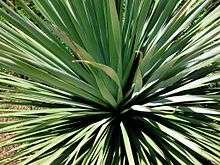Nolina nelsonii
| Nolina nelsonii | |
|---|---|
 | |
| Scientific classification | |
| Kingdom: | Plantae |
| Clade: | Angiosperms |
| Clade: | Monocots |
| Order: | Asparagales |
| Family: | Asparagaceae |
| Subfamily: | Nolinoideae |
| Genus: | Nolina |
| Species: | N. nelsonii |
| Binomial name | |
| Nolina nelsonii Rose | |
Nolina nelsonii (Blue Nolina or Nelson's Bear Grass), often misspelled Nolina nelsoni, is a flowering plant in the genus Nolina. The species was first described in 1906;[1] in its genus, it is morphologically most similar to Nolina parryi. This extremely drought-tolerant plant is native to the deserts and montane regions in the State of Tamaulipas in northern/northeastern Mexico. It is known to be cold-hardy to at least -12 °C. It develops a trunk mesuring from one to several meters high, making it an arborescent member of its genus. The bluish-green leaves, with finely toothed margins, are borne in dense rosettes, each with up to several hundred stiff linear (narrow) leaves up to 70 centimeters long. It is dioecious; upon reaching sexual maturity, its white-flowered inflorescence appears in Spring. The fruit capsules are around 80 mm in length, containing light-brown, spherical to oblong seeds 2–3 mm in diameter. After blooming, the plant's main trunk dies and multiple lateral trunks emerge to take its place.
References
- ↑ Contributions From the United States National Herbarium. Volume 10, 1906, p. 92
External links
- Several photos in habitat (2005)